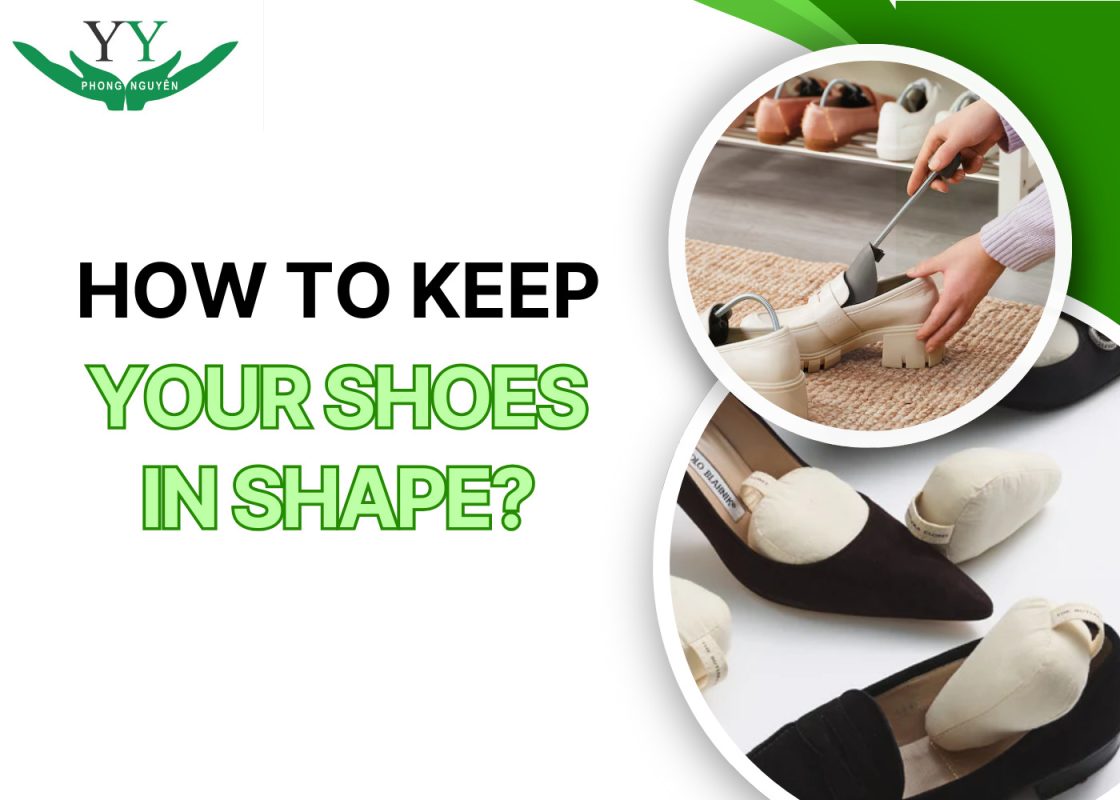Keeping your shoes in shape for long-term use is a concern for many consumers. Over time, shoes can become misshapen due to various factors. Wrinkles, collapsed toe boxes, sunken heels, or distorted uppers are all signs that your shoes are losing their original form. So, how to keep your shoes in shape?
Why Is Keeping Your Shoes In Shape Important?
Before delving into specific methods, it’s essential to understand why maintaining your shoes’ shape is so crucial. Keeping your shoes in their original form directly impacts:
- Longevity: Proper shape maintenance prevents wrinkles, collapsed toes, and sagging, especially in leather shoes like Oxfords, Derbys, or high-end sneakers. Deformed shoes are more prone to cracking over time.
- Aesthetics: Well-shaped shoes always appear neat and professional, enhancing your overall appearance, particularly in formal or office settings.
- Comfort: Maintaining the original shape ensures a snug fit, preventing discomfort caused by looseness or pressure points due to deformation.
- Cost-Effectiveness: Proper care extends the lifespan of your shoes, reducing the need for frequent replacements.

7 Ways to Keep Your Shoes In Shape
Have you ever looked down at your favorite pair of shoes and noticed they’re wrinkled, misshapen, or seriously losing their form? This can be especially frustrating when it comes to expensive shoes like leather shoes, high-end sneakers, or limited edition models.
In this section, Phong Nguyen will show you some easy ways to keep your shoes in shape—methods you can apply right at home to make sure your beloved pairs stay in perfect form, just like new!
1. Use Shoe Trees
Shoe trees are essential tools for shoe maintenance. These foot-shaped devices, typically made from cedar wood or plastic, are inserted into shoes when not in use. They work by preserving the shoe’s original shape, preventing creases and material shrinkage. For leather shoes, cedar shoe trees also absorb moisture, eliminate odors, and prevent mold growth.
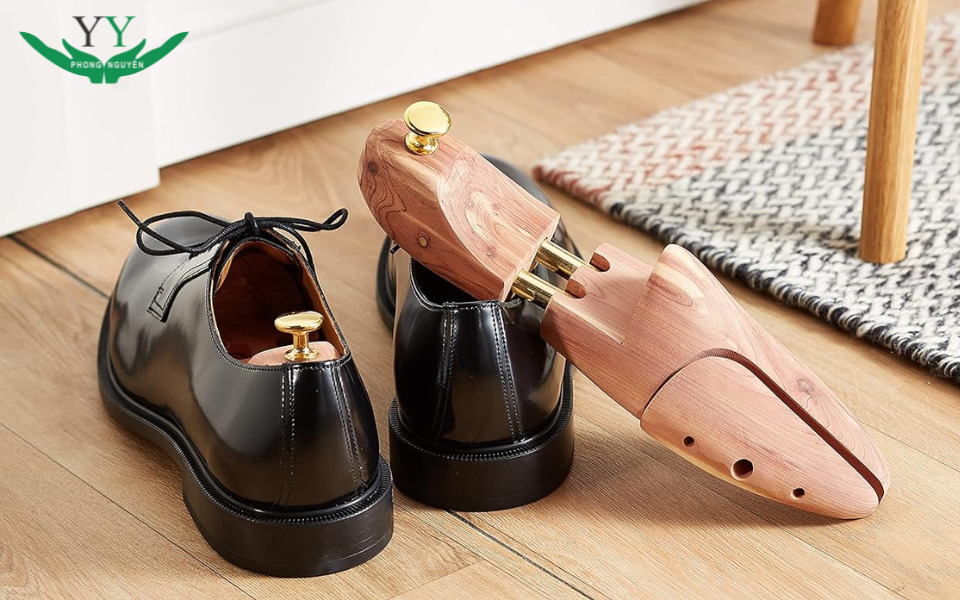
There are various types of shoe trees:
- Wooden Shoe Trees: Highly regarded for their natural moisture-absorbing and deodorizing properties, though they tend to be more expensive.
- Plastic Shoe Trees: More affordable and lightweight, suitable for travel, but lack the moisture-absorbing qualities of wood.
- Spring Shoe Trees: Adjustable in size to fit various shoe types.
When using shoe trees, ensure they fit your shoes properly. Oversized trees can overstretch the shoes, while undersized ones won’t effectively maintain the shape.
2. Stuff Shoes with Paper
Not everyone can invest in shoe trees, especially if you own multiple pairs. In such cases, stuffing shoes with paper is an effective and economical alternative, particularly for sneakers, canvas shoes, or those made from flexible materials.

Use uncolored paper to avoid staining your shoes. Old newspapers, tissue paper, or wrapping paper are suitable options. Start by stuffing the toe box, then the midsection, and finally the heel. Ensure the paper is packed firmly enough to maintain the shape without overstretching the material.
An added benefit is that the paper can absorb moisture, helping wet shoes dry faster and preventing odors. However, remember to replace the paper regularly if the shoes are damp to avoid mold growth.
3. Proper Shoe Storage
How you store your shoes significantly affects their shape retention. Here are some basic guidelines:
- Store in a Cool, Dry Place: Avoid direct sunlight, which can fade colors and damage materials. High humidity can lead to mold and unpleasant odors.
- Use Boxes or Bags: When not in use, keep shoes in their original boxes or specialized dust bags. Avoid leaving them exposed on the floor or in dusty, damp environments.
- Avoid Stacking: Do not stack shoes vertically, as this can cause pressure and deform the shoes.
- Keep Boots Upright: For boots or high-top shoes, avoid folding them during storage. Instead, keep them upright using boot shapers or by stuffing them with rolled-up paper.
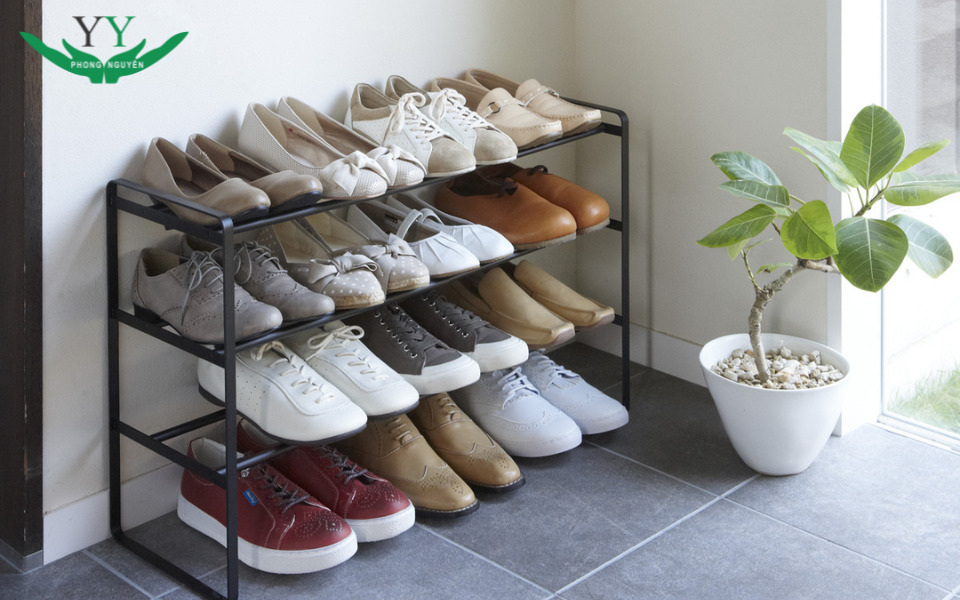
Before long-term storage, clean your shoes thoroughly, insert shoe trees or stuff them with paper, and place them in boxes or fabric bags. Avoid plastic bags, as they can trap moisture and promote mold growth.
4. Regular Cleaning and Maintenance
Regular cleaning is vital for maintaining shoe shape. Dirty shoes not only look unappealing but are also more susceptible to damage. Cleaning methods vary depending on the shoe material:
- Leather Shoes: Wipe off dust regularly with a soft brush or damp cloth. Periodically apply shoe polish or leather conditioner to keep the leather supple and prevent cracking.
- Sneakers/Canvas Shoes: Hand wash with warm water and mild soap. Avoid machine washing, as it can damage adhesives and the shoe’s structure.
- Suede or Nubuck Shoes: Use specialized brushes and protective sprays. Avoid water exposure when possible.

After cleaning, ensure shoes are completely dry before storage. Do not dry them under direct sunlight or near heat sources like dryers or heaters, as this can cause material shrinkage and deformation. Instead, let them air dry naturally in a well-ventilated area, stuffing them with paper to absorb moisture and maintain shape.
The frequency of cleaning depends on usage. For frequently worn shoes—such as those for work or school—clean them once or twice a month. For less frequently used pairs, a thorough cleaning every two to three months is sufficient.
5. Properly Putting On and Taking Off Shoes
Improper methods of wearing and removing shoes can lead to deformation. Forcing your foot into a shoe without loosening the laces or stepping on the heel can compress and damage the shoe’s structure over time.
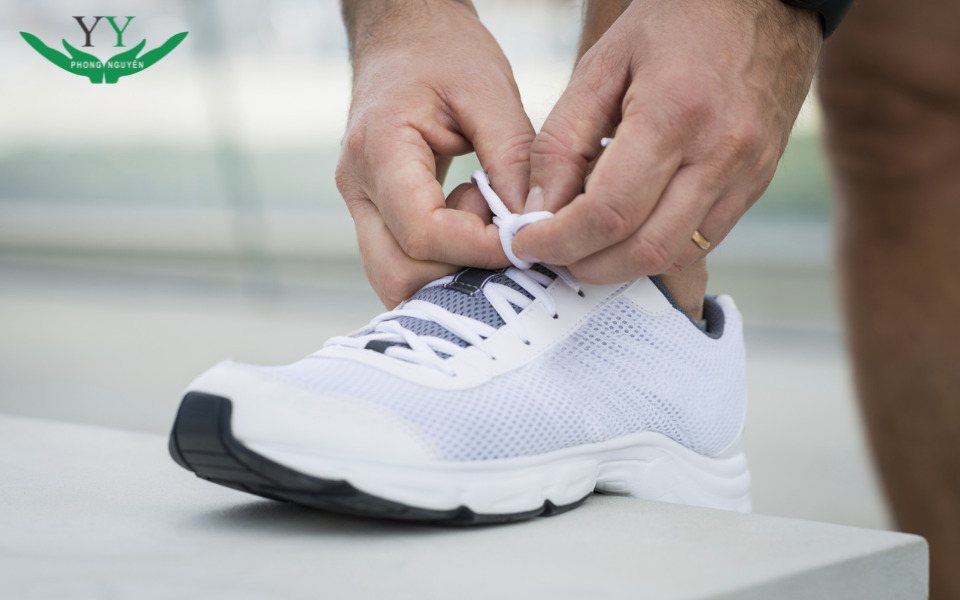
Similarly, removing shoes by stepping on the heel with the other foot without untying the laces can cause the adhesive to weaken and the shape to distort. To prevent this, develop the habit of using a shoehorn—a small tool that helps you slide your foot into the shoe smoothly, especially useful for leather shoes or low-top sneakers.
When taking off shoes, loosen the laces and gently remove your foot by hand, avoiding sudden pulls or stepping on the heel. These small actions significantly contribute to maintaining your shoes’ shape.
6. Rotate Your Shoes
Another effective tip is to rotate your shoes regularly. Instead of wearing the same pair daily, alternate between different pairs. This practice allows each pair to “rest,” enabling materials to return to their original shape and moisture to evaporate.
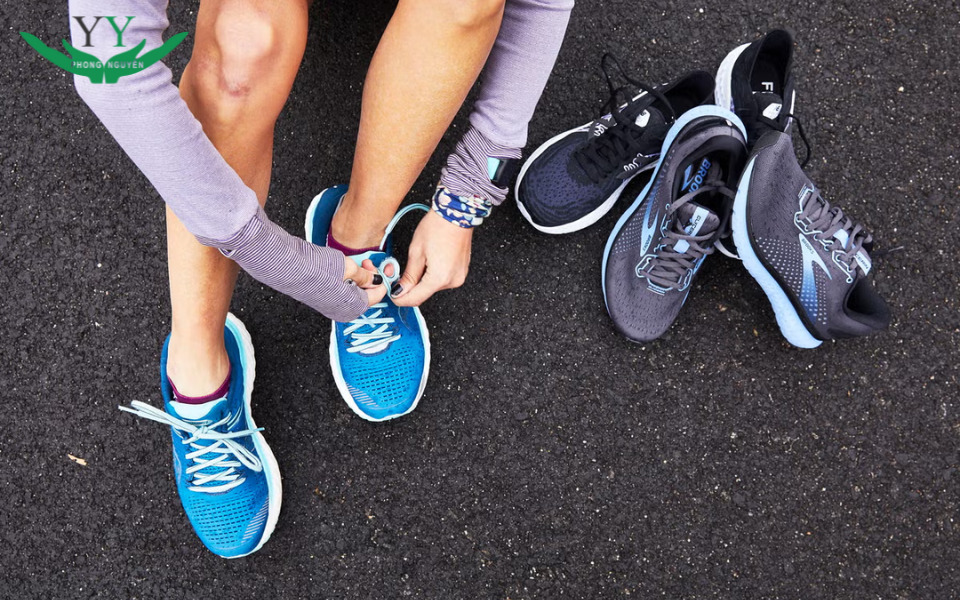
By doing so, you not only help maintain the shape but also extend the lifespan of all your shoes. If possible, avoid wearing the same pair for more than two consecutive days, especially leather shoes or those prone to deformation.
7. Use Specialized Products
Beyond shoe trees, several specialized products can help maintain your shoes’ shape:
- Toe Box Inserts: Prevent the toe area from collapsing, particularly useful for sneakers and athletic shoes.
- Heel Shapers: Designed to maintain and restore the heel’s shape, addressing common issues like sunken heels in boots and high-top shoes.
- Moisture Absorbers or Silica Gel Packs: Placed inside shoes to absorb moisture, preventing odors and mold.
- Protective Sprays: Shield shoes from water and stains while helping materials retain their elasticity and shape.
- Ventilated Shoe Racks: Storing shoes in well-ventilated areas prevents moisture buildup and deformation.
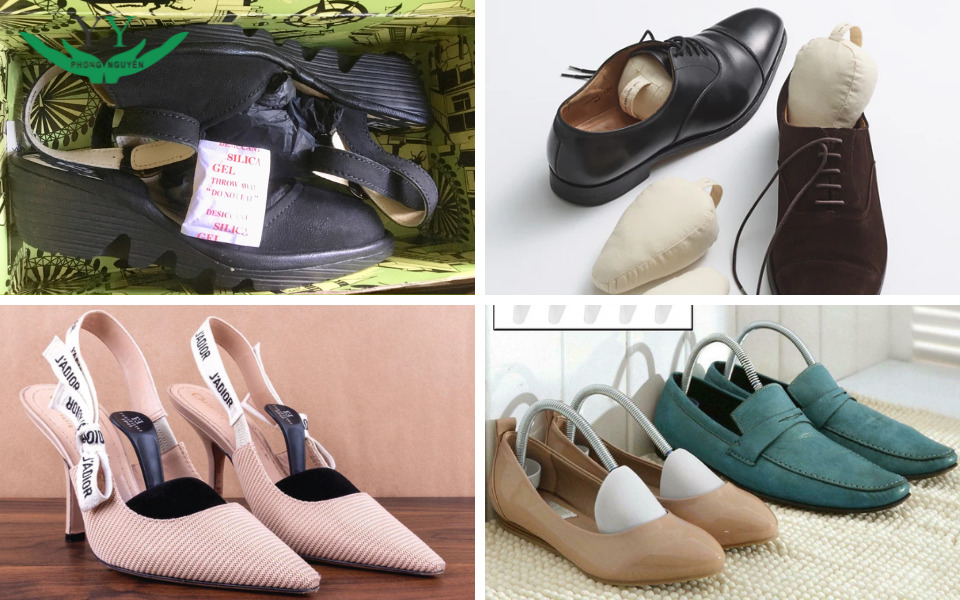
How to Restore Shoes That Have Lost Their Shape
If your shoes have already lost their form, don’t be too quick to throw them out. There are several methods to restore their original shape:
- Shoes that have collapsed or lost shape slightly: Stuff them with newspaper or packing paper (non-acidic) to fill the void and reshape the shoes. Leave them overnight or for a few days, then use shoe trees to maintain the shape.
- Leather shoes with creased or crumpled toes: Use adjustable wooden shoe trees to gently stretch the toe area, or place a damp cloth on the affected area and stuff the shoe with a shoe tree to help reshape it.
- High-top shoes with collapsed collars: Use boot shapers (tools specifically designed for boots) or stuff the collar with rolled-up newspaper or fabric to keep it upright.
- Soft, floppy fabric shoes: Stuff the shoes with paper or use plastic shoe trees to help maintain their shape.
- Shoes that have become misshapen due to pressure: Stuff them tightly with newspaper or use shoe trees to push the misshapen areas back into their original form. It may take a few days or even weeks, depending on the severity.
However, keep in mind that maintaining your shoes’ shape from the start is much easier than trying to restore a pair that’s already heavily deformed.
Conclusion
Keeping your shoes in shape not only helps save money in the long run but also ensures that your shoe collection stays in its best condition. From using shoe trees and stuffing shoes with paper, to storing them correctly, cleaning regularly, and taking proper care during wear and removal, the tips provided in this article can help you keep your shoes looking fresh and in great shape. And do not forget to bookmark this article by Phong Nguyen and implement these practices for long-lasting, well-maintained shoes!

